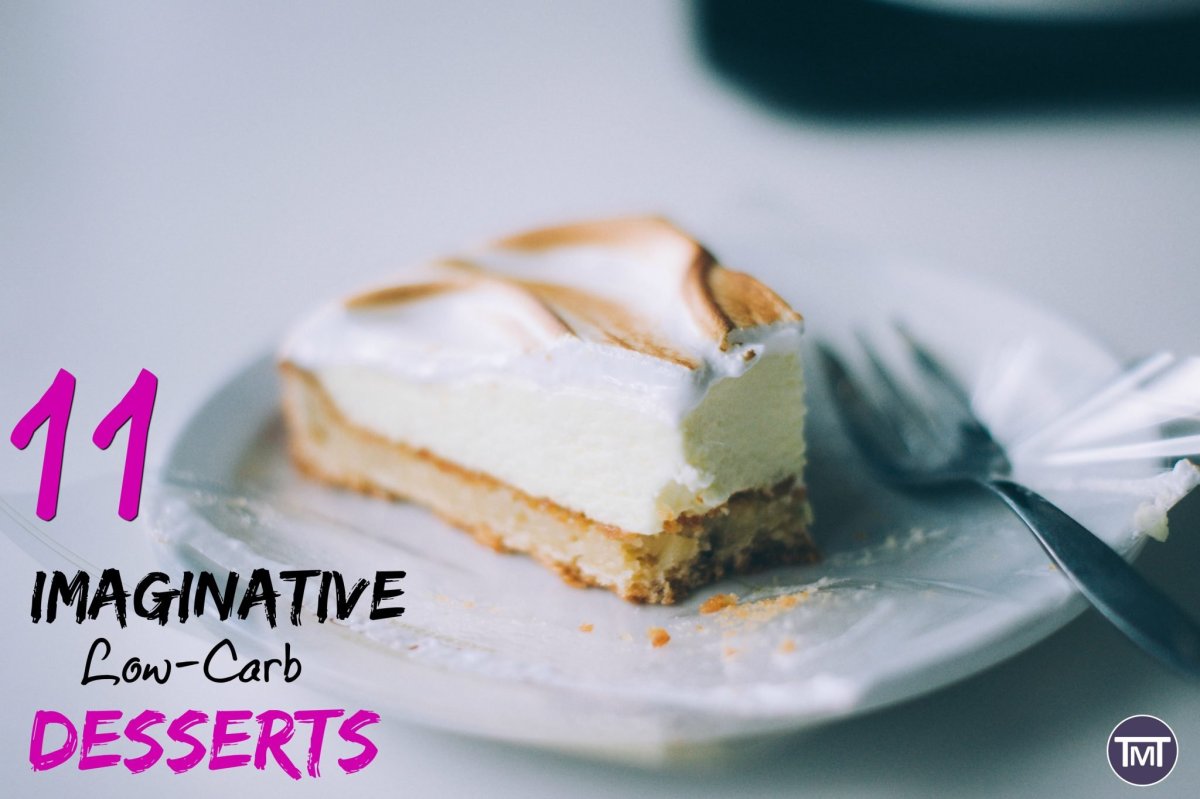Indulge your sweet cravings without the guilt! This exploration into creative low-carb desserts unveils a world of delicious possibilities for health-conscious individuals. We’ll delve into the secrets of low-carb baking, showcasing delectable recipes that are both satisfying and surprisingly simple to create. From rich chocolate mousse to creamy cheesecakes and delightful cookies, we’ll guide you through each step, transforming your kitchen into a haven of guilt-free indulgence.
Discover the versatility of low-carb sweeteners, learn essential tips and tricks for achieving perfect texture and flavor, and explore innovative ways to adapt your favorite high-carb desserts. We’ll even provide stunning visual representations to help you master the art of low-carb baking, ensuring every dessert is as visually appealing as it is delicious. Prepare to embark on a culinary journey that redefines your perception of low-carb desserts—a journey where flavor and health intertwine seamlessly.
Tips and Tricks for Low-Carb Baking
Embarking on the delightful journey of low-carb baking can present unique challenges, but with the right knowledge and techniques, you can create decadent desserts that satisfy your sweet tooth without the carb overload. Understanding the nuances of ingredient substitutions and mastering a few key baking techniques will unlock a world of delicious possibilities.
Common Challenges and Solutions in Low-Carb Baking
Low-carb baking often requires adapting recipes designed for traditional ingredients. One common issue is the altered texture and moisture content. Substituting sugar alcohols for sugar, for instance, can result in a denser, sometimes crumbly, final product. Similarly, using almond flour or coconut flour instead of wheat flour significantly impacts the structure of the baked good. The solutions lie in careful ingredient selection and the use of binding agents and emulsifiers.
The Importance of Proper Ingredient Substitutions
Successful low-carb baking hinges on the thoughtful selection of substitutes. Direct swaps rarely yield optimal results. For instance, simply replacing granulated sugar with an equal amount of erythritol might lead to a dessert that’s too sweet or has an unpleasant aftertaste. Different sugar alcohols possess varying sweetness levels and textural effects. Similarly, almond flour and coconut flour absorb liquids differently, requiring adjustments to the recipe’s liquid content. Experimentation and understanding the properties of each substitute are crucial for achieving the desired outcome. For example, using xanthan gum can mimic the gluten structure in wheat flour, creating a more cohesive texture in baked goods using almond or coconut flour.
Tips for Achieving Optimal Texture and Flavor in Low-Carb Desserts
- Mastering Moisture Balance: Coconut flour is exceptionally absorbent. Start with less liquid than a traditional recipe calls for and gradually add more until you achieve the desired consistency. Almond flour, on the other hand, requires more liquid.
- Employing Binding Agents: Xanthan gum or psyllium husk powder can help create a more cohesive structure, particularly when using alternative flours. These act as a binder, preventing crumbly textures. A typical ratio might be 1/2 to 1 teaspoon per cup of flour substitute.
- Balancing Sweeteners: Experiment with different sugar alcohols or sugar substitutes to find a blend that offers the desired sweetness and avoids aftertastes. Combining erythritol and stevia, for example, can create a more balanced sweetness profile.
- Adding Fats Strategically: Fats contribute to moisture and richness. Don’t be afraid to incorporate additional butter, coconut oil, or avocado oil to enhance the texture and flavor of your low-carb desserts. These also help prevent dryness.
- Utilizing Flavor Enhancers: Vanilla extract, almond extract, and spices can significantly enhance the flavor profile, compensating for any subtle differences introduced by low-carb substitutes. A touch of salt can also help balance the sweetness.
Creative Variations and Adaptations

Transforming beloved high-carb desserts into low-carb delights requires a blend of creativity and culinary know-how. The key lies in substituting traditional ingredients with low-carb alternatives while maintaining the essence of the original recipe’s flavor and texture. This involves careful consideration of sweetness, moisture, and overall mouthfeel. By understanding the role of each ingredient, you can successfully adapt recipes and even create entirely new low-carb masterpieces.
Adapting existing high-carb dessert recipes necessitates a strategic approach. Instead of relying solely on sugar, explore alternative sweeteners such as erythritol, stevia, or monk fruit, carefully adjusting quantities to achieve the desired sweetness level. Flour can be replaced with almond flour, coconut flour, or a blend of both, influencing the texture of the final product. For instance, a traditional chocolate cake, rich with all-purpose flour and granulated sugar, can be transformed by using almond flour for a lighter texture and erythritol for a subtly sweet taste. The addition of cocoa powder and unsweetened chocolate maintains the decadent chocolate flavor. Careful attention to baking time and temperature is crucial to avoid dryness.
Adapting Classic Recipes
The transformation of classic recipes hinges on intelligent ingredient swaps. Consider a traditional apple pie: the traditional pastry crust, rich in wheat flour and butter, can be replaced with a crust made from almond flour, coconut oil, and a touch of xanthan gum for binding. The filling, traditionally brimming with sugar and refined flour, can be made with a mixture of stevia, spices, and a generous amount of apples, enhancing the natural sweetness of the fruit. The result is a pie that’s both satisfyingly sweet and significantly lower in carbohydrates. Similarly, a rich cheesecake, often reliant on copious amounts of cream cheese and sugar, can be adapted using a low-carb cream cheese alternative and a sugar substitute like erythritol. The base can be crafted from almond flour and coconut flakes. The resulting cheesecake, while different in texture, still delivers the creamy richness of its high-carb counterpart.
Innovative Low-Carb Dessert Ideas
The realm of low-carb desserts extends beyond mere adaptations. It embraces innovation, allowing for the creation of entirely new flavor profiles and textures. Imagine a summer dessert featuring fresh, ripe berries, macerated with a touch of erythritol and lime juice, served atop a bed of whipped coconut cream. The tartness of the berries contrasts beautifully with the creamy richness of the coconut cream, creating a refreshing and satisfying dessert. Alternatively, a spiced pumpkin mousse, sweetened with monk fruit and infused with warming spices like cinnamon and nutmeg, provides a delightful autumnal treat. The velvety texture of the mousse, combined with the aromatic spices, creates a decadent yet light dessert.
Taste and Texture Comparisons
While low-carb desserts strive to emulate their high-carb counterparts, there are inherent differences in taste and texture. Low-carb alternatives often have a slightly different sweetness profile, as many sugar substitutes do not replicate the exact taste of sugar. The texture can also vary, with almond flour and coconut flour-based baked goods often having a denser, more crumbly texture than those made with traditional wheat flour. However, these differences are not necessarily negative; they contribute to the unique character of low-carb desserts. For instance, a low-carb brownie might be slightly denser and less cakey than its traditional counterpart, but it still delivers the rich chocolate flavor, albeit with a more intense, concentrated taste due to the absence of excessive sugar. The key is to appreciate these variations and to understand that the goal is not to perfectly replicate the high-carb original, but to create a delicious and satisfying low-carb alternative.
Unleash your inner pastry chef with the knowledge and inspiration gained from this guide to creative low-carb desserts. You’ve discovered the art of transforming simple ingredients into decadent treats, mastering techniques that deliver both exquisite taste and health-conscious benefits. Remember, satisfying your sweet tooth doesn’t require compromising your wellness. With the right recipes and a dash of creativity, you can enjoy delightful low-carb desserts that leave you feeling satisfied and energized. So, gather your ingredients, embrace the challenge, and savor the sweet success!
Top FAQs
What are the best low-carb sweeteners for baking?
Erythritol, stevia, and monk fruit are popular choices, each offering unique properties. Experiment to find your favorite!
Can I use regular flour in low-carb recipes?
No, regular flour is high in carbohydrates. Almond flour, coconut flour, and oat flour are excellent low-carb alternatives.
How do I store low-carb desserts?
Storage depends on the dessert. Generally, airtight containers in the refrigerator are best for most low-carb treats.
How can I make low-carb desserts more visually appealing?
Use fresh berries, nuts, unsweetened chocolate shavings, or a dusting of powdered erythritol for elegant garnishes.


